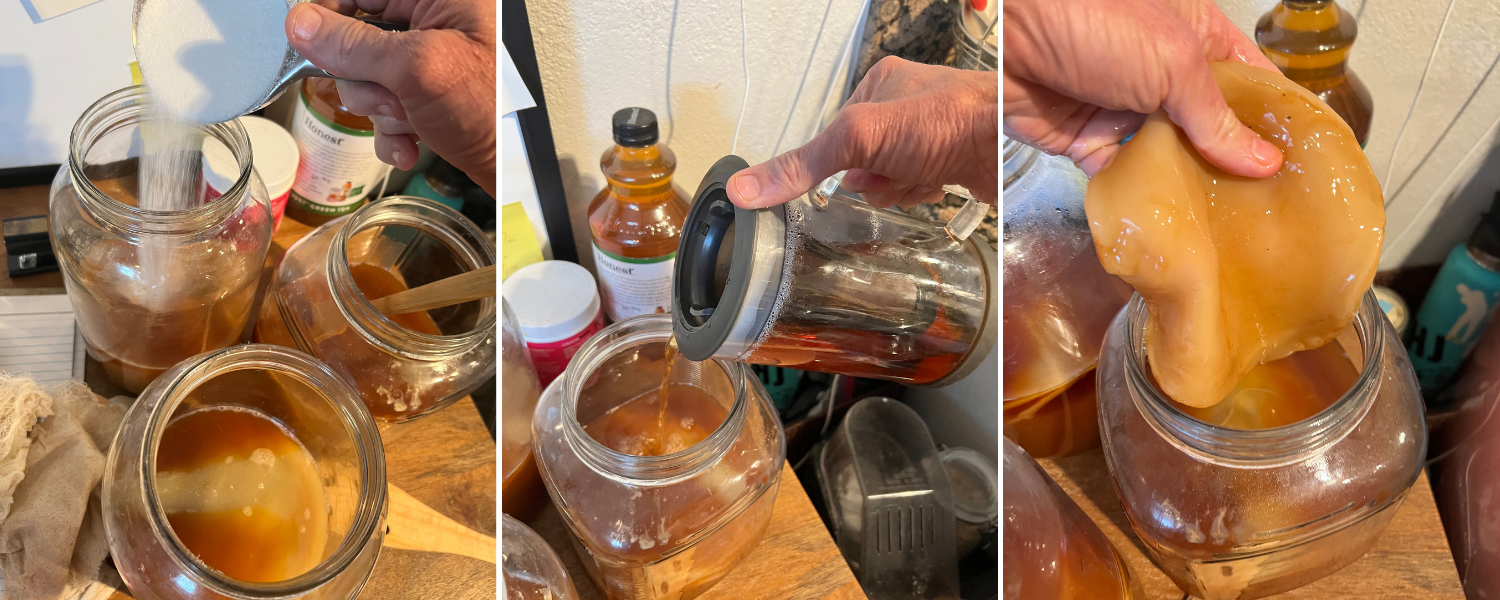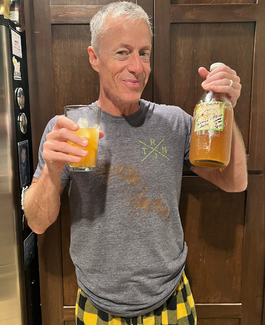I have been making and enjoying homemade Kombucha for a while now, and I’ve become pretty good at it, if I do say so myself! I’ve shared this highly-requested recipe with friends and family, so I figured it’s time I share it with all of you!
In case you aren’t familiar with Kombucha, it’s a fermented beverage—the same as beer, wine, kefir, etc. It is also one of the oldest and safest foods on earth, considering this is what our ancestors did to food in the days before refrigeration, and has been made for thousands of years (click on the link for more details on all aspects of kombucha). Aside from being a fantastic source of probiotics, studies show that Kombucha has antifungal properties and can support heart health through its ability to positively impact cholesterol levels, as well as reduce blood pressure and improve digestion! (However, it is also important to note that this beverage is not recommended for everyone—specifically those who are currently pregnant or breast-feeding, or who have a histamine intolerance.)
In the great resource, The Big Book Of Kombucha, I read a section about the risks and concerns pertaining to homemade Kombucha, such as the worry that sometimes the SCOBY will turn moldy. The authors actually said that it is still okay to drink it, placing it in the same realm as eating spoiled cheese—it’s not considered dangerous. Sometimes, I do like to freak my daughter out and take a bite out of the SCOBY itself—lots of probiotics!
Below you will find the full list of instructions. It honestly makes it seem more complex than it really is—you just buy the gallon jar, make sweet black tea, then ferment it with a SCOBY….and that’s Kombucha!
You’ll need:
Flavoring for second fermentation:
My favorite flavor is Good Earth Spicy Tea, plus freshly squeezed lemon and/or lime juice.
Other options could be anything from diced ginger root to diced turmeric root, and even jalapeño! Berries also work really well, and you only need just a few blueberries, strawberries, raspberries, blackberries, or pomegranates. Mint from the garden is good too, and I’ve also tried combining turmeric and ginger root, which turned out to be very tasty.
For the first fermentation:
- Take the SCOBY culture and 1-2 cups of its own kombucha as your starter (you MUST get this from a kombucha maker).
- Make a gallon of very sweet, very strong black tea. Use 8 bags of black tea + 1 cup of sugar in a sufficient amount of water. Let it cool, then add the SCOBY and kombucha.
- Cover the mixture with cheesecloth and let it sit for 7-14 days in a dark, room temperature area. 77F is actually ideal, but never hot or direct sun. If it’s too cold, the kombucha won’t ferment. Hence, if you want to just preserve a SCOBY (always in its own kombucha liquid), stick the jar in the fridge.
- Taste your fermented kombucha—it should be not too sweet and not too vinegar-y.
- Save the SCOBY with 1-2 cups of Kombucha and use the rest for the 2nd fermentation.
The second fermentation:
Add kombucha to new bottles with a tightly sealed lid. Perhaps use small bottles if you want flavor variety. I reuse liter bottles of store bought kombucha with a tight screw-top lid. Add assorted flavors, such as ¼ cup – ½ cup of fruit juice or fresh fruit. I use lemon juice, lime juice, and tea bags. Seal the bottle and ferment it at room temp for three more days. The longer you ferment it for the second time, you increase carbonation and reduce sweetness. And if you’re more of a visual learner, check out this Youtube video, How To Make Kombucha, to see how it’s done.
Additional details:
You’ll need:
- One large glass/metal jar or bowl that has a wide opening. You want to avoid using a plastic jar or bowl because the chemicals in the plastic can leach into the kombucha during the fermentation period. It’s also possible that ceramic pots might cause lead to leach into the kombucha once the acid comes into contact with the ceramic glaze. Look for a big metal or glass jug/jar/bowl online or in large kitchen stores, and make sure the opening is wide enough to allow a lot of oxygen to reach the kombucha while it ferments.
- One large piece of cloth or dish towel to secure around the opening of the jar with a rubber band. It is not recommended to use a cheese cloth since this allows particles to pass through. You can even try using an old thin cotton t-shirt or some simple cotton fabric from any textile store.
- One SCOBY disk. You will need to purchase a “SCOBY” disk and can find one either in health food stores or online at very inexpensive prices. A SCOBY disk can be vacuumed-sealed in a small pouch and shipped directly to your house for only a few dollars, while still preserving all of the active yeast ingredients.
- Eight cups of water (preferably filtered, but people who use tap water feel this works fine too). Some prefer using distilled water which will contain less contaminants or metals than tap water will. Distilled water is inexpensive (only like 88 cents a gallon) and can be found at most large drug or convenience stores.
- 1/2 cup of organic cane sugar or honey. When it comes to sugar substitutions, some feel that it’s not a good idea to substitute cane sugar for another kind of sugar. The quality of the sugar is important in order to avoid contaminants, so look for organic sugar. Yes, this is one of the few times we’ll tell you to use real sugar! Most of it is actually “eaten” by the yeast during the fermentation process, so there is very little sugar actually left in the recipe by the time you consume it.
- Four black tea bags (preferably organic which some people have reported works better). Some people also like to use green tea, although black tea is the kind used traditionally in most cases.
- One cup of pre-made kombucha, which you can either buy or use from a previous kombucha batch that you or a friend made.
Directions:
- Bring your water to boil in a big pot on the stovetop. Once boiling, remove from the heat and add your teabags and sugar, stirring until the sugar dissolves.
- Allow the pot to sit and the tea to steep for about 15 minutes, then remove and discard tea bags.
- Let the mixture cool down to room temperature (which usually takes about one hour). Once it’s cooled, add your tea mixture to your big jar/bowl. Drop in your SCOBY disk and 1 cup of pre-made kombucha.
- Cover your jar/bowl with your cloth or thin kitchen towel, and try to keep the cloth in place by using a rubber hand or some sort of tie. You want the cloth to cover the wide opening of the jar and stay in place, but be thin enough to allow air to pass through.
- Allow the kombucha to sit for 7–10 days depending on the flavor you’re looking for. Less time produces a weaker kombucha that tastes less sour, while a longer sitting time makes the kombucha ferment even longer and develop more taste. Some people have reported fermenting kombucha for up to a month with great results, so taste test the batch every couple of days to see if it has reached the right taste and level of carbonation you’re looking for.
Notes from The Big Book of Kombucha
Contents
¾ cup of sugar for 1-gallon vessel (evaporated cane juice aka raw sugar, or plain white)
2 tablespoons of black tea (you can also use other teas)
1–2 cups starter from top of hotel + 1 SCOBY pancake (4–5oz)
Fermenting #1
Ferment at 75-85F for 10–14 days. Colder than that may take longer to ferment. Use a side heater, not a bottom heater, as this messes with yeast
Fermenting #2
Fruit juice, tea bags, more sugar, dried fruit for 1–4 days at room temperature
After removing flavorings, ferment for 1–4 more days at room temperature
Fermenting #1
75-85F ferment for 10–14 days. Colder than that may take longer to ferment. Use a side heater, not a bottom heater (messes with yeast)
Fermenting #2
Fruit juice, tea bags, more sugar, dried fruit: 1–4 days at room temperature
1–4 more days after removing flavorings at room temperature
General Notes
Hotel: 60F is ideal with a cheesecloth or lid in the fridge if you want to slow growth
Drain the yeast every 2-6 months if it’s collecting on the bottom
Sugar Content: 200g per gallon or 12.5g/8 ounces
Ferments down 50-70% in 7-14 days, to between 2-6g per cup (this is low glycemic sugar)
My typical long ferment might be 3g/cup or 12g in a quart
Don’t worry about carbonation as the store drinks are faked!
When traveling: put SCOBY and starter 3oz in Ziploc bag, then in a towel, then in another (big) Ziploc bag
Shopping List:
Black tea. You want a lot of simple, straight black tea. I do loose leaf brewing, so I get a big open bag of black tea.
Sugar. Just get plain ‘ol regular sugar—the only time I will recommend doing so!
Scoby.
If you want more gallon jars to make more, click here. I also like these quart jars, which are fun to flavor the kombucha, and then you can give some to your friends!
Have fun trying out this recipe and let me know how it turns out!
Bonus:
How To Make Tepache
Shout out to my son Jack for introducing me to another delicious and equally easy to make fermented beverage—Tepache!
Tepache is a fermented Mexican beverage that is similar to Kombucha, but this time made with pineapple (and a few other ingredients).

1 pineapple
3/4 cup of brown sugar
8-10 cups of water
A couple of cinnamon sticks
Instructions:
1. Chop up the pineapple and save the pineapple slices.
2. Dump all of the rind into a big pitcher or gallon sized Kombucha jar. Mix in the water, sugar, and cinnamon.
3. Cover with a breathable cheesecloth and ferment for 2-3 days. If foam accumulates on top, this confirms fermentation. You can scrape it off.
4. After 2 days, taste a spoonful and it should be a pleasant pineappleflavor. If you wait too long, it can turn vinegary with more alcohol.
5. Dump out the solids and strain the finished product into a bottle with a sealed lid.
6. Perform a second fermentation for 2 days and then refrigerate.
7. Mix with carbonated mineral water for a fantastic soft drink experience with probiotics and minimal sugar. Enjoy!










